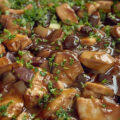When I was growing up, my Bubbe, God bless her, wasn't exactly a top-tier chef, but she had her culinary moments. One of those moments was all about farfel and corn. Yeah, you heard me right, farfel. My family went bonkers over this stuff, especially when we jazzed it up with some mushrooms and onions instead of the corn (actually the more common way it was served, not sure where the corn came from). It was like our own little comfort food secret.
If you haven’t heard of farfel you might have heard of this thing called egg barley. It is like a close relative of farfel—similar, but not quite the same. Farfel was the original homemade version and egg barley was the more modern cousin, both delicious, but to me there is something special about the old school irregular pieces of farfel.
 Package of traditional farfel
Package of traditional farfel
So, what's the lowdown on farfel?
According to the Jewish food historian Gil Marks, it's essentially an egg noodle often shaped like a tiny barley grain. But here's where it gets interesting: farfel refers to any small, oddly-shaped food bit.
So, back in the day in Germany, noodles were the new kid on the culinary block. They made this soup with these basic noodle clumps and called it varvelen. German Jews caught wind of this noodle madness and dubbed those little doughy pellets "farfel" in Yiddish. Nope, it's got nothing to do with those fancy Italian butterfly pasta shapes. The process was kinda like dough sword fighting—hacking it with a knife. But then things got easier and safer. Some folks rolled the dough into logs and grated it through rough holes, while others sliced it into strips and chopped those strips into bits. Either way, they ended up with these little nuggets of delight that they'd spread out to catch some sun and dry out.
Over time the term farfel was also applied to other irregular food bits, including the Ashkenazic version of streusel and especially to crumbled matzah. To differentiate them Americans sometimes refer to the noodles as barley farfel.
Now, fast forward a bit, and you've got farfel taking the lead in Poland and Ukraine. It was like the OG pasta before pasta was even cool. They'd make heaps of it, dry it out under the sun, and stockpile it for the cold months when fresh veggies were hard to come by.
Here's a neat tidbit: the Baal Shem Tov, founder of the Hasidic movement, would chow down on farfel on Friday nights because it sounded like the Yiddish word for "done." It's like saying, "Look, whatever happened this week, it's a wrap." Talk about a creative way to set the weekend mood.
Oh, and don't miss this: "farfellen" in Yiddish also means "thwarted" or "doomed." Super fitting for Rosh Hashanah, right? It's like a way of saying, "Let's leave all the not-so-great stuff behind and hit refresh." We express the wish that our misdeeds should fall away and those who wish us ill should be "thwarted”.
We use a more round farfel for the occasion to symbolize the hope that the coming year will be well-rounded as well as the circular nature of life. The numerous pieces symbolizes fertility and abundance. Plus, some even throw in a blessing to keep the bad vibes away. Learn more about symbolic foods for Rosh Hashanah here.
Once farfel became commercialized it was often made in machines resulting in more uniform and usually round pieces. In modern Israel, a type of round farfel (ptitim) is marketed under the name couscous and can be substituted for farfel.
Cooking farfel is like a culinary adventure with multiple endings. Boil it up like pasta, or give it a simmering pilaf treatment—your call. It's the ultimate sidekick for soups, stews, and pot roasts. And let's not forget the mushroom twist. Farfel became such a sensation that it practically had its own VIP section at Jewish delis and Catskills resorts in the US.
Farfel has been making waves for generations. It's a dish worth passing down. Now go out there and give farfel a try—it's like a bite-sized piece of history on your plate. Get my recipe to make your own farfel from scratch and then cook up some farfel with mushrooms.

















